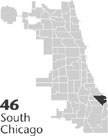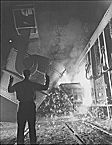| Entries |
| S |
|
South Chicago
|
 Community Area 46, 10 miles SE of the Loop. Situated at the mouth of the
Calumet River,
South Chicago first evolved as a rural settlement for fishermen and farmers. In 1833, speculators began buying up land, projecting that the area would become developed because it would connect outside shipping routes. The town was first named Ainsworth. Settlers included
Irish
Catholics, who established St. Patrick's parish in 1857. South Chicago's location at the intersection of river and
railroad
transportation
routes fostered early growth.
Community Area 46, 10 miles SE of the Loop. Situated at the mouth of the
Calumet River,
South Chicago first evolved as a rural settlement for fishermen and farmers. In 1833, speculators began buying up land, projecting that the area would become developed because it would connect outside shipping routes. The town was first named Ainsworth. Settlers included
Irish
Catholics, who established St. Patrick's parish in 1857. South Chicago's location at the intersection of river and
railroad
transportation
routes fostered early growth.
Following the Great Fire of 1871, industry migrated south from Chicago proper. Swedes, Scots, Welsh, and Germans provided skilled labor for the flourishing steel, grain, railroad, and lumber industries. The Brown Iron and Steel Company opened its doors on the Calumet in 1875, followed by the South Works of North Chicago Rolling Mill Company in 1880. A commercial area serving the growing number of workers developed around South Works at Commercial Avenue and 92nd Street. South Works provided the steel that fortified many of the city's landmarks, such as the Sears Tower and McCormick Place.
A part of the Township of Hyde Park, South Chicago was annexed to Chicago in 1889. At the time of annexation, half of the area's residents had been born outside the country.

|
In 1919 a major strike against U.S. Steel erupted, involving some 365,000 workers nationwide. Though the strike proved unsuccessful, it drew recent, unskilled immigrants into union activities. Mexicans were first hired as strikebreakers in 1919, eventually becoming one of the largest, most stable Latino communities in the Midwest.
The Great Depression era witnessed intense battles over worker efforts to unionize. At South Works, union activists led by George Patterson captured the company-sponsored employee representation plan, and in 1937 won company recognition of the Steel Workers Organizing Committee as an independent bargaining representative. SWOC became the United Steelworkers International Union of America (USWA) in 1942. USWA Local 65, with headquarters on South Commercial Ave., emerged as one of the community's key power bases and played a role in larger civic affairs.
After World War II, refugees from Serbia and Croatia came to South Chicago, and its racial and ethnic composition began to shift as the descendants of earlier European immigrants left for the south suburbs. By the 1980s, African Americans constituted almost half of the population, and Latinos, many recent immigrants from Mexico, nearly 40 percent. Concurrently, South Works endured a prolonged shutdown of its facilities. Though the union attempted to restore the mill's economic viability by agreeing to many concessions, USX, successor to U.S. Steel, closed South Works in April 1992, preferring to concentrate production at its larger, nearby Gary Works.
South Works' decline damaged local businesses. The South Chicago community reached out to city leaders to support redevelopment schemes, including a new airport, a plan to host the summer Olympics, and new enterprise zones, all without ultimate success. In 1998 urban planners began a new study of the area's potential for redevelopment. In 2002 the Solo Cup Company began construction of a new facility on the southern portion of the former South Works plant.
| South Chicago (CA 46) | |||||
| Year |
Total
(and by category) |
Foreign Born | Native with foreign parentage | Males per 100 females | |
| 1930 | 56,683 | 23.6% | 23.6% | 114 | |
| 51,659 | White (91.1%) | ||||
| 738 | Negro (1.3%) | ||||
| 4,286 | Other (7.6%) | ||||
| 1960 | 49,913 | 13.9% | 1.3% | 98 | |
| 47,338 | White (94.8%) | ||||
| 2,448 | Negro (4.9%) | ||||
| 127 | Other races (0.3%) | ||||
| 1990 | 40,645 | 15.4% | — | 89 | |
| 6,835 | White (16.8%) | ||||
| 25,016 | Black (61.5%) | ||||
| 78 | American Indian (0.2%) | ||||
| 184 | Asian/Pacific Islander (0.5%) | ||||
| 8,532 | Other race (21.0%) | ||||
| 13,644 | Hispanic Origin* (33.6%) | ||||
| 2000 | 38,596 | 13.2% | — | 86 | |
| 5,008 | White alone (13.0%) | ||||
| 26,647 | Black or African American alone (69.0%) | ||||
| 161 | American Indian and Alaska Native alone (0.4%) | ||||
| 55 | Asian alone (0.1%) | ||||
| 27 | Native Hawaiian and Other Pacific Islander alone (0.1%) | ||||
| 5,775 | Some other race alone (15.0%) | ||||
| 923 | Two or more races (2.4%) | ||||
| 10,565 | Hispanic or Latino* (27.4%) | ||||
The Encyclopedia of Chicago © 2004 The Newberry Library. All Rights Reserved. Portions are copyrighted by other institutions and individuals. Additional information on copyright and permissions.